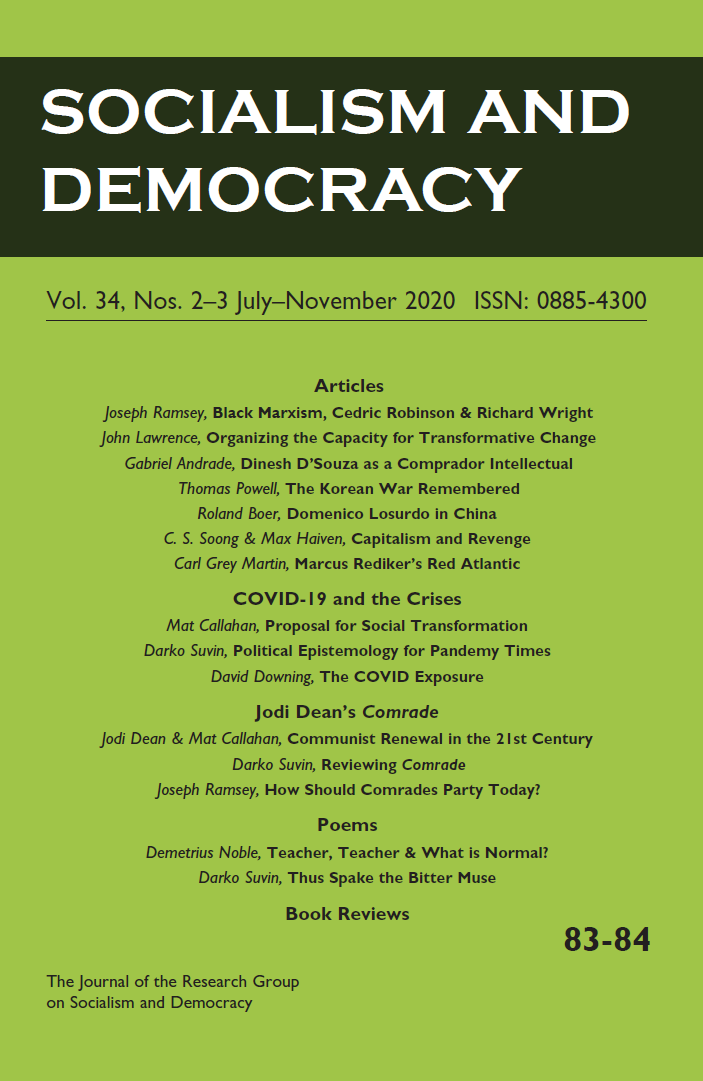Michael Joseph Roberto, The Coming of the American Behemoth: The Origins of Fascism in the United States, 1920-1940, New York: Monthly Review Press, 2018, 463 pp., $25.00.
Michael Roberto’s book offers a riposte to mainstream liberals and so-called #NeverTrump conservatives such as William A. Galston, David Frum, and Yascha Mounk, who have lately taken to fretting about the descent of liberal-democracy into fascism. Roberto shows that much of this wailing and gnashing of teeth stems from a failure to distinguish accurately between what is new about recent events, and what is not. After reading his carefully executed work, little doubt remains. There is not much, aside from the speed and reach of ideological mis-information, that is novel about the current crisis. As happened in the 1920s and 1930s, when Franz Neumann and Lewis Corey defined fascism as the ownership and control of government by finance capital, since 2008 an alliance of political elites and oligarchs has sought to establish such control by deepening private property rights while sustaining the rule of law and representative government. As Roberto shows, commentators who pushed against the mainstream in the 1920s and 1930s saw that American fascism would differ from overseas variants. As was the case then, and today, much mainstream commentary looks abroad to establish a comparative ‘fascist minimum.’ This underplays what is distinct about efforts by monopolists to own and control government in this nation-state.
As then, and today, the primary objective of American fascist movements is to undermine the democratic impulse that threatens concentrated wealth. Roberto’s detailed recovery of once well-known but now largely forgotten empirical analyses demonstrates clearly that the American form of fascism is a latent tendency of the market economy, which liberal-democratic political institutions allow to manifest at certain critical junctures. Between the 1920s and 1940s, Marxist and non-Marxist scholars alike clearly understood this fact. American fascism threatens when those in charge of the political system shift gears, from growing profits in a ‘boom’ to defending income in a ‘bust.’ For this reason alone, Roberto’s resuscitation of work by Corey, Carmen Haider, A.B. Magil and Henry Stevens, Mauritz Hallgren, and Robert A. Brady is an invaluable resource for readers in the second decade of the twenty-first century.
Yet, there is more. Roberto provides a good overview of the New Era boosterism pervasive in the 1920s. Readers will be unsurprised by Roberto’s summary of Corey’s and Magil and Steven’s accounts of how in the 1920s the “unprecedented buildup of the means of production raised the profits for capitalists to new heights but at the expense of workers who were increasingly displaced from production.” (68) It is around this point that Roberto’s analysis takes off. Critics were acutely aware that a major factor at play in the transfiguration of fascism in these decades was the relationship between Big Business, the mainstream commentariat, and downwardly mobile middle-, lower middle-, and working-class ‘aspirationals.’ Corey, Magil, Stevens, and Hallgren understood that the bust of 1929 broke the aspirationals’ confidence in their ability to scale the commanding heights of the market economy. By linking aspirationals’ ideological meltdown to Big Business’ reaction to the crisis of profitability, readers are shown that the bait and switch game central to Trumpism is par for the course in a system designed to defend market growth over other social goods or attendant conceptions of justice.
Roberto neatly unpacks the tension between two visions of the aspirational society that first arose in the 1920s, one held by the new consumer-citizens and one held by the “quiet but more powerful forces” (108) of big business owners and managers, and their political allies. The vision of democracy associated with consumer-citizenship was for the democratization of capitalism. This ideal was promoted by figures such as Thomas Nixon Carver, who tirelessly celebrated the inevitable “coming of universal wealth and uninterrupted progress.” (110) The latter vision was based on collective realization on the part of owners and managers that they needed to organize politically to protect and enhance their economic interests. Drawing on James Warren Prothro’s 1954 account of the development of ‘business theory’ in the early 1920s, Roberto describes how work by pro-business anti-democrats such as Charles Norman Fay and Edward Bernays was actively disseminated through vehicles such as the National Association of Manufacturers, the United States’ Chamber of Commerce and later, the American Liberty League. At the core of ‘business theory’ stand four tenets that will seem very familiar to all but the most cosseted of contemporary readers: Establishment of a political hierarchy was necessary to avoid mob rule; Labor should be encouraged to identify with capital on the basis of a nationalistic ideal, in the case at hand, “True Americanism”; The classical liberal idea of private vices contributing in aggregate to public virtues should be actively promoted among the intellectually trained; while at the same time, business elites should engage in conspicuous philanthropy at all levels, local, state, and national, to counter “the pernicious influence of radicals, organized labor, and the mob.” (115)
The flourishing of aspirational resentment alongside this wealth and income defense strategy is what finally transformed a latent tendency into a potentially manifest quality. As Hallgren showed, whereas most working-class Americans were rendered little worse off by the crash, insofar as they had seen scant improvement in their material life-conditions over the 1920s anyway, those for whom the ‘ballyhoo’ machine had been working at full-tilt saw conditions deteriorate rapidly from 1929 onwards. ‘Big Business’ could not ignore the dangers posed by radicalization of this class, and ‘business theory’ provided a guide to those dedicated to stymying such ‘pernicious influences.’
Roberto draws a subtle point from the critical analyses, one that the mainstream commentariat fails to acknowledge. Due to the contingencies of American cultural history, many who flocked to the urban industrial centers during the boom had been repulsed by the licentiousness of consumerist America, even as they themselves aspired to greater wealth and respectability. This latent rural Puritanism served big business well after the crash of 1929. These morally upstanding citizens’ resentment, which had been present throughout the boom, boiled over into anger, and fueled renewed support for True Americanism. Calling on work by Nancy Maclean, Roberto shows that the vehicles for this resentment were racist, chauvinist, anti-Semitic and anti-Catholic gangs, notably the Klu Klux Klan. Yet, here is the punch-line. Roberto makes clear that aspirational resentment alone, no matter how ugly, does not an American fascist movement make. Those citizens whom Gilbert Seldes in 1943 labeled “‘small fry fascisti’” (254) and even their erstwhile leaders, radio announcer Father Charles Coughlin, Louisiana Senator Huey Long, and the now largely forgotten William Dudley Pelley and Gerald B. Winrod, for example, proved in the end to be little more than very useful idiots to those advocating anti-democratic ‘business theory.’
Against the backdrop of the Roosevelt Administration’s flailing early effort to establish the New Deal, it had become clear to many commentators that a uniquely American fascism was in the offing. But, mainstream centrists were preoccupied with communicating to their fellow citizens the threats posed, on the one hand, by ‘small fry,’ and on the other hand, by an out-of-control Roosevelt-headed Executive branch. What Roberto shows is that critical commentators knew well where the genuine threat to citizenly interests lay. In his words, the “Roosevelt administration had propped up Big Business, which had itself become a system of power in its own right.” (252) Following Roosevelt’s 1936 re-election and the pressures exerted by “labor and progressive groups …” that had successfully convinced the Administration to attend to the needs of “those left behind by the recovery,” it was in fact “Big Business” that posed the only genuine threat. (252)
Once more, as in the 1920s, 1930s and today, political elites and the mainstream commentariat portray politics as a confrontation between ‘good’ versus ‘bad’ forms of capitalism. This draws attention away from the kinds of knowledge that citizens require if they are to act upon the democratic impulse, and build a republic committed to sustaining equal liberty for all. Perhaps more importantly, the mainstream commentariat must be faulted for drawing citizenly attention away from oligarchic efforts to use this rule of law and these institutions of representative government and individual rights to defend and expand concentrated wealth against the democratic impulse. What Michael Roberto’s book clearly shows is that the present crisis of liberal-democracy is not an aberration but a structural feature of that political system. Roberto’s book deserves a wide audience, not only among students and scholars of American Studies and History, but among the many lay readers who I suspect will agree with him when he suggests in closing that “the gangster state that Franz Neumann saw …” as the objective of fascist agitation (408) has today arrived.
Andrew Scerri
Department of Political Science, Virginia Tech
Blacksburg, VA
ajscerri@vt.edu

